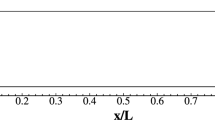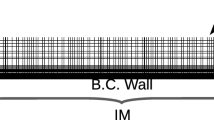Abstract
For an accurate evaluation of the increase in skin friction due to various surface topographies on ships, i.e. plate roughness, coatings, or bio fouling, both experimental measurements and a numerical evaluation of those measurements are necessary. The measurements are necessary as no other practical method exists to evaluate the skin friction coefficient on most surface topographies, and numerical evaluation is required to compute the roughness effects of varying ship types and speeds. Therefore, a method for measuring the skin friction coefficient for bio-fouled and structured surfaces at full-scale friction velocity is presented, and a validation of the design and measuring procedures is given. For the ship frictional resistance calculations, the Computational Fluid Dynamics (CFD) code ShipFlow has been modified to take the added friction into account.
Similar content being viewed by others
Author information
Authors and Affiliations
Additional information
Received: January 30, 2002 / Accepted: February 3, 2003
RID="*"
Acknowledgments. The authors are grateful to the MASTEC program (funded by the Foundation of Strategic Research) for funding the research. We would also like to thank Prof. Per Jonsson, and Dr. Kent Berntsson, from Tjärnö Marine Biological Laboratory. Finally, thanks are due to Dr. Leif Broberg, Flowtech, for assistance with the implementation into ShipFlow.
About this article
Cite this article
Leer-Andersen, M., Larsson, L. An experimental/numerical approach for evaluating skin friction on full-scale ships with surface roughness. J Mar Sci Technol 8, 26–36 (2003). https://doi.org/10.1007/s10773-003-0150-y
Issue Date:
DOI: https://doi.org/10.1007/s10773-003-0150-y




